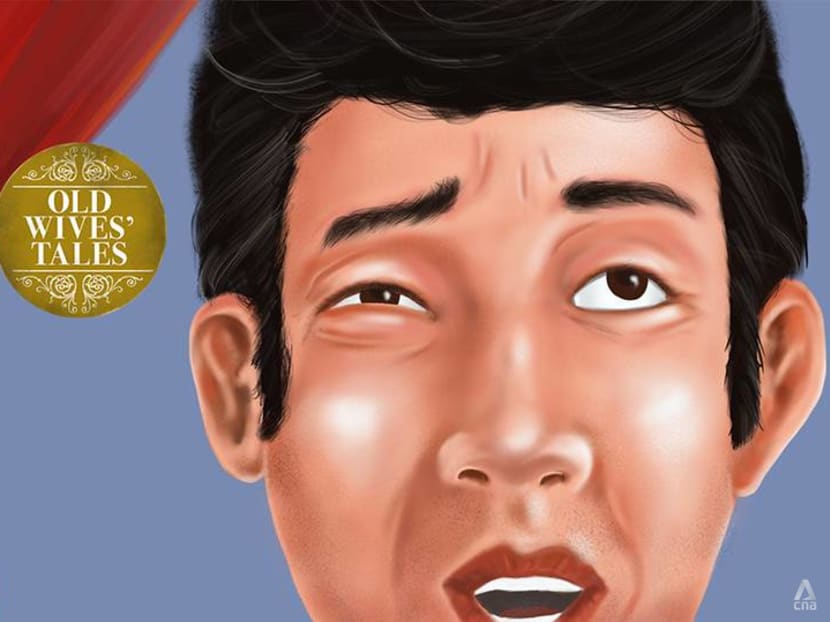Myth busting: A twitching eyelid means someone is thinking of you
CNA Lifestyle continues its series debunking some commonly held notions about health and wellness. This month, it’s about how twitching eyelids are an omen – not.

(Art: Jasper Loh)
The twitching can happen out of nowhere and it can feel like your eyelid is getting electrocuted. And that’s actually not far from the truth.
Your eyelid “jumps” because of the intermittent bursts of electrical activity in the nerves that control your eyelid muscles, according to Dr Loo Jing Liang, the head and senior consultant with the Singapore National Eye Centre’s Neuro-Ophthalmology Department.
READ: Myth busting: Pluck out a strand of grey hair and 10 more will grow in its place
That’s the more scientific explanation for these seemingly random bursts of electrical activity – and makes more sense than the superstitious belief that twitching is a sign that someone is thinking of you.
Some even ascribe different meanings to the timing of the twitch and which eyelid twitches. For instance, some believe that a left-eye twitch after 7pm could mean an impending argument. But if it happens in the right eye, you’re in for some unexpected gains.
WHAT CAUSES EYELID TWITCHING?
For all the mystery that old wives’ tales associate with twitching, the action could just simply be your eyes’ reaction to fatigue, strain, stress, too much caffeine, dryness or excessively oily lids, said Dr Loo.
The most common form of benign twitching is known as eyelid myokymia and its intermittent frequency can last for several days to weeks, said Dr Loo. “One of my patients described it as feeling a heartbeat below her eye. It affects only the lower or upper eyelid on one side,” she said.
Sometimes, instead of just your eyelid, one half of your face could be affected, too. “The eyelid closes as if it is winking and half the mouth is drawn upwards,” said Dr Loo, describing the intermittent and involuntary muscle contractions seen in hemifacial spasms.
READ: Myth busting: Smacking the warm bus seat before sitting prevents piles
There’s also benign essential blepharospasm (BEB), where both eyes can close without your doing so. It starts off as an increased frequency in blinking when there is bright light, wind or stress, said Dr Loo. Then, you may find yourself closing your eyes uncontrollably.
WHEN DOES THE TWITCHING BECOME AN ISSUE?
You can see how BEB is potentially an issue as daily activities such as driving or crossing the road become hazardous.
What experts such as Dr Loo are also concerned with is that BEB can sometimes progress to involve other muscles in the lower part of the face and neck in a condition known as Meige Syndrome. “The patient may experience involuntary lip pursing, chewing or tongue movements,” she said.

BEB, which rarely resolves on its own, has also been reported to be caused by neurological conditions such as stroke and Parkinson’s disease, added Dr Loo.
That’s not forgetting hemifacial spasms, which are mostly thought to be caused by the compression of the facial nerve by a normal blood vessel that has enlarged with age
“Rarely, in less than one per cent of the time, it is due to a brain tumour compressing the facial nerve,” she said. Like BEB, hemifacial spasm also does not resolve without medical intervention.
In short, if the twitching involves half of your face, or both eyes simultaneously and is persistent, seek medical attention, advised Dr Loo.
ARE THERE TREATMENTS FOR THE TWITCHING?
If the twitching bothers you – and there aren’t any underlying medical issues – simple measures such as getting adequate sleep and breaks from computer work would help, said Dr Loo, who also advised laying off the coffee and using lubricating eye drops.
To help with oily lids, use over-the-counter lid cleansers or baby shampoo diluted with warm water, said Dr Loo. “Use a cotton bud or pad to gently wipe your lid margin near the root of the lashes in a horizontal direction, twice a day.”
READ: Myth busting: Why pregnant women develop dark patches on the face
Treatments for hemifacial spasms involve magnetic resonance imaging to determine the presence of any blood vessel pressing on the facial nerve as well as neurosurgery to remove the vessel. Botulinum toxin may also be injected into the eyelids and facial muscles to relieve the spasms. These jabs may also be used for the same purpose in BEB.
“Repetitive injections are required as the effect of the injection will wear off, typically after four to six months,” said Dr Loo.





